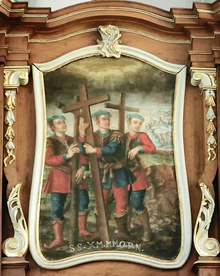Achatius of Armenia


Achatius († approx. 140 on Mount Ararat ; also called: Achaz , Akakios ) was a Roman officer and Christian martyr . He is venerated as a saint . His feast day is June 22nd in the Catholic Church and March 31st in the Orthodox Churches .
Legend
In view of the legendary sources, historical security is difficult or even impossible. He is easily confused with other martyrs of the same name, especially with Achatius of Byzantium († 303/304 in Constantinople ), who, according to legend, is also a captain in the imperial army and is counted among the fourteen helpers in need. His name in Hebrew means "God keeps", Greek means "the innocent".
He is referred to as Primicerius , i.e. the leader in the Roman army. He was sent to Armenia with 9,000 soldiers to put down an uprising there. However, the luck of war was not on their side and so they were on the verge of suffering defeat. Seven angels came to them and promised them victory if they professed Christ. So they converted to Christianity and gained victory. When the Emperor Hadrian heard that the army had converted to Christianity, he sent a barbarian army to fight the apostates. At first, the attackers could not harm Achatius and his companions, which induced 1000 barbarians to convert to Christianity as well. Finally, Achatius and the 10,000 soldiers on Mount Ararat were torn to pieces with thorn branches and then crucified.
presentation
Because of his suffering, Achatius is often depicted with a thorn bush or a wreath of thorns, but also as a knight, duke or nobleman with a flag, large cross and sword. Due to further confusion or confusion of legends, he is sometimes also depicted with episcopal insignia. It should protect against evil diseases and the fear of death.
Adoration
The worship of Achatius was spread throughout Europe during the Crusades . The legend was supposed to motivate the crusaders to persevere in difficult situations.
The parish churches of Atteln , Grünsfeldhausen , Murau , Ramingstein , Rheinhausen (Breisgau) , St. Achaz in Munich-Mittersendling , Schladming , Kottingbrunn and Zahlbach (Mainz) are consecrated to him. The chapel in Grünsfeldhausen shows the octagonal / octagonal floor plan of the Holy Sepulcher in Jerusalem , which was brought from the Holy Land by the Crusaders .
painting

- around 1419: Master of the Wernigerode Altarpiece , on the altarpiece in the Hessisches Landesmuseum , Darmstadt, the murder of Count Dietrich von Wernigerode is depicted with a stab in the neck. The scene is surrounded by scenes from the life of St. Achatius.
- 1508: Albrecht Dürer: Martyrdom of ten thousand Christians , oil painting on canvas, 99 × 87 cm; Kunsthistorisches Museum , Vienna
- 1763: unknown artist: Altarpiece '10000 Martyrs' on the Jakobus altar of the parish church of St. Peter and Paul Villmar , three of the martyrs are depicted, in the middle Achatius.
See also
- Legend of the Ten Thousand Martyrs
- Acacius
swell
- Luc Campana: The 14 Holy Helpers. Origin and admiration - competition with medicine - life and legends - reach and images. Lauerz: Theresia-Verlag, 2009, ISBN 978-3-03767-035-4 .
- Sabine Kimpel: Achatius and the 10000 Martyrs of Armenia - In: Lexikon der Christian Ikonographie , Tl. 5 S. 16-21 (1973).
- Paul W. Roth: Soldiers Saints , Verlag Styria, Graz Vienna Cologne, 1993, ISBN 3-222-12185-0
- Otto Wimmer, Hartmann Melzer: Lexicon of Names and Saints , Nikol Verlag, Hamburg, 2002, ISBN 3-933203-63-5
Individual evidence
- ↑ Friedrich Wilhelm Bautz: Achatius (Agathius, Acacius). In: Biographisch-Bibliographisches Kirchenlexikon (BBKL). Volume 1, Bautz, Hamm 1975. 2nd, unchanged edition Hamm 1990, ISBN 3-88309-013-1 , column 17.
Web links
| personal data | |
|---|---|
| SURNAME | Achatius of Armenia |
| ALTERNATIVE NAMES | Achaz; Akakios |
| BRIEF DESCRIPTION | Roman officer and Christian martyr |
| DATE OF BIRTH | 1st century or 2nd century |
| DATE OF DEATH | at 140 |
| Place of death | Ararat |